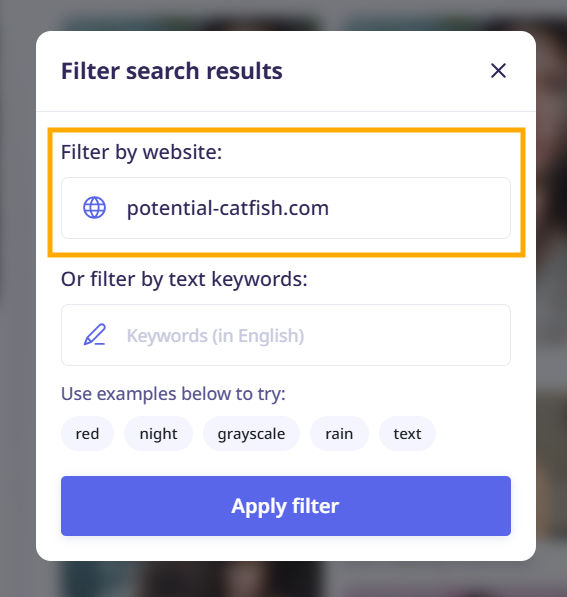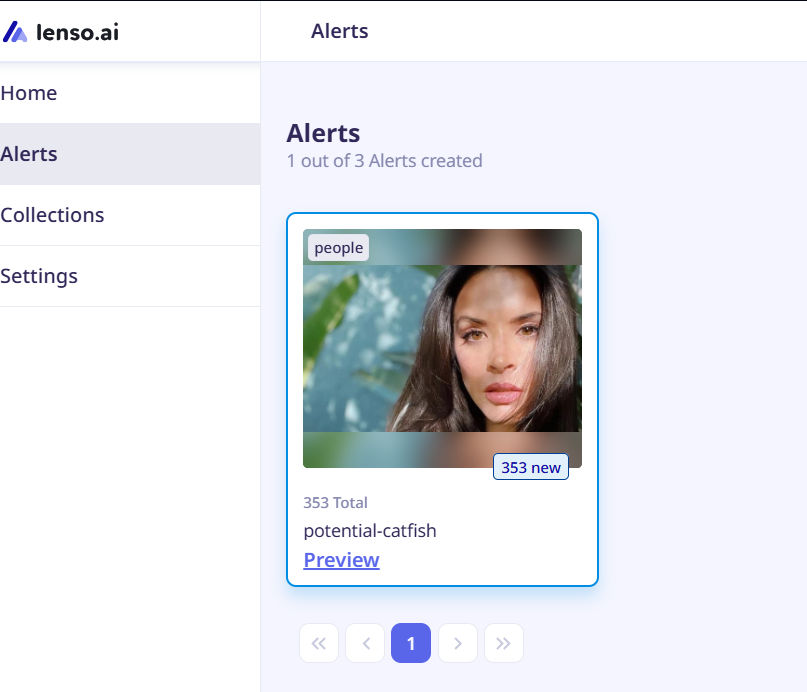
Preview in:
How do catfish operate online?
Catfishers often create fake profiles using stolen or manipulated photos and false personal details. Their goal can vary from emotional scams and fraud to identity theft. They might try to build trust quickly, share dramatic stories, or avoid video calls. To learn more about safeguarding your personal information, consider reading the Cybernews NordProtect identity theft protection review.
How to tell you’re being catfished? Most effective tips
One of the most effective ways to spot a catfish is by using a reverse face search engine. These tools allow you to upload a photo of the person you suspect and quickly scan the internet for matching images.
This can help you uncover whether the photo is being used elsewhere - possibly under different names or on suspicious profiles. With just a single image, you can reveal if someone is trying to deceive you by using stolen pictures. It’s a fast, easy, and powerful method to verify and protect yourself from online scams.
Facial recognition. What is it and why do we need it?
Best Face Search Tools to spot catfish online
If you want to find more information about the person in the photo and verify whether it’s a catfish, we recommend using these face search tools:
- Lenso.ai – The best reverse image search tool with its own facial recognition engine. With lenso.ai's face search, you can find accurate face matches and check all available sources where the specific image has been published.
- PimEyes – A well-known facial recognition engine that also finds face matches across the web.
- Facecheck.id – Another solid alternative for face search. It provides results along with a match accuracy percentage.
- Surepass 1:n Face Search: An advanced Face Search Technology to find an accurate face match. 1:n Face Search provides results within seconds and streamlines the process. Ideal for identity verification and user authentication
Top 3 Face Search Sites That Actually Work – Don't Get Scammed
Spot catfish online using the best facial recognition tool - lenso.ai
We'll walk you through how to spot potential catfish online - using lenso.ai as a practical example.
Love or Fraud? How to spot and avoid online Valentine’s Day scams
Reverse image search on lenso.ai - step by step
- Go to lenso.ai
- Upload/paste an image of a potential catfish
- Check the results (first you will see the overall image search results)

For an in-depth face search, check the 'People' category

Don’t stop there - check all available URLs below each photo. They might help you find more information about the person. Someone may have already shared the image with a warning.

Use filters and sorting options
Lenso.ai’s image search offers additional features that can help you refine your investigation.
Use filters:
- By specific domain – try entering domains where users warn others about potential scammers or catfish.
- By keyword – add relevant keywords to narrow down the results.

Use sorting options:
- Best/Worst match
- Newest/Oldest
- Random
These options can help you quickly find the most recent information about a potential scammer or focus on the most relevant results.

Create Alerts for specific images
If you can’t find any information about a potential catfish right now but still have doubts, lenso.ai can help. Create an alert for the image and select the "People" category. You’ll receive email notifications whenever lenso finds new face matches.
This way, you’ll quickly find any new information or feel reassured if nothing suspicious appears.

Besides facial recognition search, lenso offers:
How else can you protect yourself from being catfished online?
- Be cautious with friend requests and messages. Don’t accept invitations from strangers on social media or dating apps, especially if their profiles seem empty, too perfect, or recently created.
- Suggest a video call. A real person should have no problem with a quick video chat. If they constantly make excuses or avoid calls, that’s a major warning sign.
- Think before you click. Avoid clicking on links sent by people you don’t know - or even from known contacts if the message seems out of character. Many scams start with phishing links that can steal your data or infect your device.
- Protect your personal information. Never share sensitive details like your home address, credit card numbers, passwords, or ID documents with someone you’ve only met online.
- Verify before you trust. If something feels off, it probably is. Do a reverse image search, check their story for inconsistencies, and ask specific questions that a scammer might struggle to answer.
- Look out for inconsistencies in their story. Catfish often slip up with conflicting details. Check for timeline mismatches, vague answers, or changing backstories.
- Stay skeptical, stay alert. Scammers often rely on emotional manipulation, rushing you into decisions, sharing dramatic stories. Always take your time and trust your instincts.
Continue reading

Guides
How to Find Locations from an Image? | Place Search Online
Looking for buildings, places, locations and landmarks online used to be a struggle. Nowadays, in the age of Google Maps and Place Finders, such as lenso.ai, it’s easy to locate any place from just a photo. In this article, we will show you how you can find places from a photo and refine your search with various filters.

Guides
How to prevent image theft on exclusive content platforms?
Unfortunately, image theft is one of the most common forms of online crime. It often leads to copyright misuse, unauthorized usage, and scams that can seriously damage a creator’s brand and income. So how to prevent image theft on exclusive content platforms and protect your online presence?

Guides
3 Best Google Lens alternatives for reverse image search
Tired of using Google Lens, which brings less and less accurate results in its image search? It’s time to try something new: check out the 3 best Google Lens alternatives for reverse image search.

Guides
How Reverse Image Search Can Help Detect Unauthorized Logo Usage
Unauthorized logo usage, such as your logo appearing on counterfeit products or scam sites, can severely damage your brand reputation. Take a look at how reverse image search can help you put a stop to these actions and make your brand identity more secure online.

Guides
AI image search with lenso.ai: How to find and protect your photos online?
Images that were once shared online stopped being safe and protected. There are many situations where images get leaked, and you’re not even aware of it. So how can tools like lenso.ai’s image search help you find and protect your photos online?
